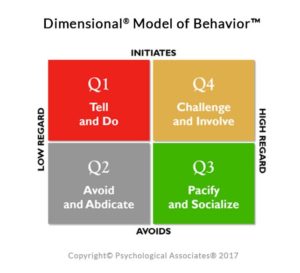
Who’s in Charge Around Here? The Challenges of Ad Hoc Teams
Ad Hoc Teams
Have you ever been on an ad hoc project team where is was unclear who had the power? How you approach ad hoc leadership can be tricky. In this case study, we’ll reveal your best approach so you can maximize your success on ad hoc teams.
The Situation
Managing power relations is a critical part of your leadership behavior. Whether working with a boss, direct report, or colleague, all of us adjust our behavior to some degree, depending on who we’re working with. As a Q4 collaborative leader, your awareness of interpersonal dynamics can give you insights for working with others more effectively.
Leadership Ambiguity
But what about situations where the power relationship isn’t so evident? For instance, you could be working on a temporary cross-functional team that draws together employees from many different parts of the company.
There is also informal power. Upper management may bring in someone outside of the firm to work with employees. That person is not on the organization chart, but he/she definitely wields power. What about when a senior executive’s relative works for you? Or is your boss?
How Do You Deal With Ambiguity?
The point is: These situations are not clear. So, what is the best strategy if you are in a situation where you don’t know who has the power in a work relationship?
Let’s say you are working on ad hoc teams with people from other departments. In terms of job titles, there is no formal power relationship between the two of you. With regard to the power dynamic, how should you begin this working relationship?
Your Choices:
No, please try again.
Unilaterally Taking Control
It may be true that someone should lead the effort for this project. However, it is not collaborative for you to decide unilaterally that you will formally take the reins of authority to expedite work on the project.At best, it puts your colleague in an awkward situation; and at worst, you will appear Q1 — coercive and pushy. Choice A certainly is dealing with ambiguity, but likely at the expense of your partner’s motivation and enthusiasm. For a better way to start off on the right foot in ad hoc teams, see B.
Presume the Other Person Has Authority. Exert Q4 Leadership.
Choice B will have you coming out a winner, no matter the actual power circumstances. If your partner on the project has Q1 tendencies, then he/she will not feel threatened by your actions. But if you take the helm automatically, the other person may be put off.After you give this person the leeway to be in charge, you may discover that he/she has Q2 or Q3 tendencies that avoid decisive leadership. If that’s the case, you can exert your own informal power. You can apply Q4 leadership strength to get moving and accomplish your project’s goals.
As we often say, you should employ Q4 leadership skills in any situation, even if you’re not formally in charge. This strategy is the best guarantee that you will work together well. You’re dealing with ambiguity by putting the project’s goals ahead of any need to dominate.
Having Someone Decide Who’s in Charge
Choice C, asking someone else to decide who’s in charge, you won’t endear yourself to your boss — or anyone else. We are occasionally thrown into leadership ambiguous situations where it is not evident who has the power. But outside of the military, most organizations don’t find it necessary to keep such strict chains of command.Most likely, management’s reaction would be, “Can’t you just work it out yourselves?” And they would be right. Part of being a good leader is showing initiative to figure out solutions yourself, not rely on the boss to spell out every step along the way. This problem doesn’t rise to the level of an intervention. Answer B provides the best course for navigating leadership ambiguity.
No, please try again.
After Ad Hoc Teams
Now that you know how to manage leadership ambiguity on ad hoc teams, check out our other teamwork and leadership tips.
Our leadership development and team development resources can help you grow as a leader, and drive your team to higher levels of synergy and high performance.
Finally, to keep in the know regarding new people leadership tips and resources, and upcoming events, please sign up for our monthly newsletter.










